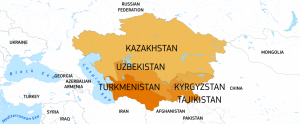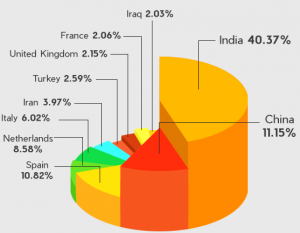DAILY CURRENT AFFAIRS (JANUARY 28, 2022)
THE INTERNATIONAL RELATIONS
1. INDIA-CENTRAL ASIA VIRTUAL SUMMIT
THE CONTEXT: Indian Prime Minister hosted the first India-Central Asia Summit in virtual format which was attended by Presidents of the Republic of Kazakhstan, Kyrgyz Republic, Republic of Tajikistan, Turkmenistan and Republic of Uzbekistan.
THE EXPLANATION:
- During the summit, a comprehensive Joint Declaration was adopted by the leaders that enumerates their common vision for an enduring and comprehensive India-Central Asia partnership.
- The Prime Minister and the Central Asian Leaders discussed the next steps in taking India-Central Asia relations to new heights. Also, leaders agreed to institutionalize the Summit mechanism by deciding to hold it every 2 years on regular meetings of Foreign Ministers, Trade Ministers, Culture Ministers and Secretaries of the Security Council to prepare the groundwork for the Summit meetings. An India-Central Asia Secretariat in New Delhi would be set up to support the new mechanism.
- The Leaders discussed the cooperation in areas of trade and connectivity, development cooperation, defence, and security and, in particular, oncultural and people to people These included a Roundtable on Energy and Connectivity;Joint Working Groups at senior official level on Afghanistan and use of Chabahar Port; showcasing of Buddhist exhibitions in Central Asian countries and joint counter-terrorism exercises.
- Prime Minister also discussed the evolving situation in Afghanistan with the Central Asian leaders. The leaders reiterated their strong support for a peaceful, secure, and stable Afghanistan with a truly representative and inclusive government.
Value Addition:
India- Central Asia relations:
- India invited 5 central Asian countries leaders for 73rd Republic Day chief guest, however the world witnessing the omicron virus disease, it has been cancelled. On the light Indian Prime Minister hoisted the first India- Central Asia virtual Summit. This summit was part of India’s reach-out to the former Soviet States, that intensified since 2015, when Prime Minister visited all five capitals.
- India joined the Shanghai Cooperation Organisation (SCO) in 2017, which all Central Asian States other than Turkmenistan are members of.
- The India-Central Asia dialogue was launched in 2019, and in July 2021, External affairs Minister attended the Central Asia-South Asia connectivity conference.
- Maritime connectivity remains important, this summit strengthen India’s initiatives through Chabahar and through the al North South Transport Corridor.
- It is also part of the present government’s attempts to bring together immediate neighbours and “far neigh- bours” in a group format on multiple occasions. Govt. invited SAARC and BIMSTEC group leaders to his swearing in ceremonies in 2014 and 2019 respectively and invited 10 leaders of the ASEAN as Republic Day guests in 2018.

THE HEALTH AND SOCIAL ISSUES
2. FIRST HUMAN PAPILLOMA VIRUS (HPV) VACCINATION DRIVE IN DELHI
THE CONTEXT: The Human Papilloma Virus (HPV) vaccination drive in Delhi, which is aimed at preventing cervical cancer among young women, has been one of the casualties of regular classes in schools being suspended for the Covid-19 pandemic.
THE EXPLANATION:
- Delhi became the first state in the country in November 2016 to launch HPV vaccination as a public health programme. In 2017 and 2018, Punjab and Sikkim, too launched their own programmes.
- According to the officials, around 13,000 girls received the vaccines in Delhi from 2016-2020. But closed schools resulted in a steep decline.
What is Human Papilloma Virus (HPV)?
HPV infection is a viral infection that commonly causes skin or mucous membrane growths (warts). There are more than 100 varieties of human papillomavirus (HPV). Some types of HPV infection cause warts, and some can cause different types of cancer.
HPV is a group of more than 150 viruses that cause ‘papilloma’, or warts, in parts of the body, including the genital areas. It is primarily spread by skin-to-skin contact and is responsible for a number of diseases, including cancers, especially cancer of the cervix (the neck of the uterus).

India’s Status:
- India has a high caseload of cervical cancer, and it ranks second among all cancers in Indian women, after breast cancer. And HPV is believed to be associated with more than 80 per cent cervical cancer cases.
- According to government data, an estimated 1,23,907 new cervical cancer cases are detected annually in India. Every year, 77,348 deaths occur from it. At any given point of time, nearly 4,20,000 cervical cancer cases are present in the country.
Approval for inclusion in UIP awaited
According to records of the World Health Organization (WHO), over 100 countries across the world have fully or partially introduced HPV vaccines in their national healthcare schedules — they include the US, UK, Canada, Australia, South Africa, Brazil, Argentina, New Zealand, Spain, Portugal, France and Japan.
India is not one of them, according to records of the central government and the WHO.
THE ECONOMY
3. THE VIRTUAL BANKING
THE CONTEXT: According to a new paper from the Bank for International Settlements, the rise of virtual banking across the Asia region will boost financial inclusion, but regulators will need to ensure consumer data is protected.
THE EXPLANATION:
- According to the BIS paper, India and Singapore may offer a model for creating a platform under central bank supervision that facilitates the sharing of personal data with financial service providers, with customer consent. At the same time, new data — or information capital — can be used to make decisions on lending instead of relying on traditional sources of collateral, which regulators will also need to monitor.
- Also, the research noted, the access to bank accounts is increasing, the use of the financial system to save and borrow is low both for developing economies and those with high levels of income and education, a gap that can be closed by technology.
- Also, its suggested, under debt resolution regimes where both virtual and high street banks are subject to the same regulations, unsecured lending poses a higher risk of loss to lenders. Keeping losses at a minimum requires more frequent assessment and the use of tailored loans that meet repayment abilities.
About Bank for International Settlements
- It carries out its work through its meetings, programmes and through the Basel Process – hosting international groups pursuing global financial stability and facilitating their interaction.
- Established in 1930, the BIS is owned by 63 central banks, representing countries from around the world that together account for about 95% of world GDP.Its head office is in Basel, Switzerland and it has two representative offices: in Hong Kong SAR and in Mexico City, as well as Innovation Hub Centres around the world. India is a member.
What is Virtual Banking?
The Virtual Banking is the provision of accessing the banking and related services online without actually going to the bank branch/office in person. Simply, availing the banking services through an extensive use of information technology without any requirement for the physical walk-in premises is called as virtual banking.
THE INTERNAL SECURITY AFFAIRS
4. GORKHA, TIWA MILITANTS SURRENDER IN ASSAM
THE CONTEXT:With over 200 militants of the United Gorkha People’s Organisation (UGPO) and Tiwa Liberation Army (TLA) formally laying down arms in a ceremony in Guwahati.
THE EXPLANATION:
- The organisations are the Tiwa Liberation Army (TLA) and the United Gorkha People’s Organisation (UGPO).Formed in 2014 to cater to the aspirations of the Tiwa community, the TLA was active in the Morigaon, Nagaon and West Karbi Anglong districts of central Assam.
- The UGPO, formed in 2007, was mostly active in the Bodoland Territorial Region and the Biswanath district.
- During the function, the Chief Minister also distributed a financial grant of ₹1.5 lakh each to 462 members of five other extremist groups who had surrendered earlier.These disbanded groups are Rabha National Liberation Front, Adivasi Dragon Fighters, National Santhal Liberation Army, National Liberation Front of Bengalis and United People’s Revolutionary Front.
- According to the Assam Chief Minister, only two active insurgent groups now remain in the state, namely the United Liberation Front of Asom-Independent (ULFA-I) and Kamtapur Liberation Organisation (KLO).
QUICK FACTS:
Tiwa tribe:
|
THE PRELIMS PRACTICE QUESTIONS
QUESTION OF THE DAY 28TH JANUARY 2022
Q. Which of the following tribes do not have major population in state of Assam?
a) Tiwa
b) Bodo
c) Rabha
d) Angami
ANSWER FOR 27TH JAN 2022
Statement 1 is incorrect: National awards such as Bharat Ratna, Padma Vibhushan, Padma Bhushan and Padma Shri do not amount to titles within the meaning of Article 18(1) of the Constitution and thus are not to be used as prefixes or suffixes to the name of the recipient in any manner.
- Article 18(1) abolishes all titles. It prohibits the State to confer titles on anybody whether a citizen or a non-citizen. Military and academic distinctions are, however, exempted from the prohibition. Thus, a university can give title or honor on a man of merit.
Statement 2 is incorrect: Padma Awards were instituted in 1954 to be awarded to citizens of India in recognition of their distinguished contribution in various spheres of activity.
- The government suspended the practice of granting the Padma awards for two years in 1977. It was again suspended during mid-1992 when 2 PILs were filed in the High Courts of India
- They are given in three categories: Padma Vibhushan (for exceptional and distinguished service), Padma Bhushan (distinguished service of higher-order) and Padma Shri (distinguished service).
Statement 3 is incorrect: A maximum of 3 people can be awarded the Bharat Ratna.
The total number of Padma awards to be conferred each year is limited to 120. But the count excludes posthumous awards and any non-resident Indian or Overseas Citizen of India or foreign-based winners.




